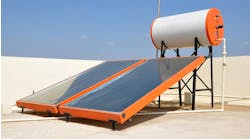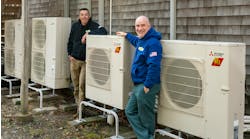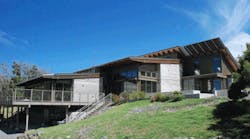Latest from Solar
Sponsored
Hawai'i Preparatory Academy’s Energy Lab demonstrates best practices in sustainability
KAMUELA, HAWAII — The Big Island of Hawaii is home to the first school building, the Hawai‘i Preparatory Academy’s Energy Lab, in all of Hawaii to receive U.S. Green Building Council LEED Platinum certification. The Energy Lab, which features indoor and outdoor classroom areas, conference and project rooms, a workshop area, and learning tools to facilitate a sustainable learning environment, also obtained certification from the Living Building Challenge, a program focusing on seven performance areas: site, water, energy, health, materials, equity and beauty, making it the first K-12 school facility in the world to receive this status.
Completed in January 2010, the Energy Lab, which is off the grid for water and waste and is also zero-net energy, uses 30% of the energy it captures, and provides energy for the school’s 220-acre campus. The building utilizes an energy and operational monitoring and control system, an experimental radiant cooling system, photovoltaic panels, and a rainwater harvesting system, among other technologies to conserve energy and water, allowing students to learn about renewable energy and efficient systems first hand.
Related Articles:
Bossert builds Hawaii’s first certified green home
“Initially, our goal was to become a prototype learning center demonstrating best practices in sustainability, and we thought LEED would be our goal,” explained Dr. Bill Wiecking, Energy Lab director, who was involved with both the development and design of the Energy Lab. “We then decided to go for LEED 2.0 for schools, which includes rigorous integration of the space into our curricula. At some point in our planning meetings, the Living Building Challenge was mentioned. ‘There's no way you could do that here, it's crazy,’ we were told. So we naturally decided to do it.”
When asked how much power on average does the building use, Wiecking said, “The national average use for buildings is about 10 kWh/sq.ft. per year. The average for schools in Hawaii is 15 kWh/sq.ft. per year. Ours is 3.23 kWh/sq.ft. per year. We do this by aggressive monitoring, automation of vampire loads, and cultural shift among the students.”
Ample solar, wind available
Hawaii is known for its trade winds and sunny weather, so it was natural to utilize these renewable energy sources.
“We've installed three discrete types of PV systems, so students can evaluate cost and performance in various conditions,” said Wiecking. “Students learn total cost of ownership and return on investment for renewable energy systems, which enables them to do research on a college level while in high school. Our wind systems vary from Air-X small 400 Watt turbines used to power our field weather stations to a larger demonstration VAWT that lasted only about a month, then self destructed. It never produced significant power.”
Even though the large demonstration VAWT is no longer in use, the three Air-X 400W mini turbines for field stations have been operating for up to four years in 22 mph average winds, with a monthly 50 mph period, according to Wiecking.
The photovoltaic system is made up of Sanyo panels. Overlooking the deck are 14 Sanyo HIT Double panels, 195 Watts each. There are also 48 panels with enphase inverters and another 60 panels feeding SMA inverters, each panel is 210 Watts.
According to Wiecking, 27 kW are being produced, which at 5.5 hours per day is about 155 kWh per day.
“We use 30%-45% of this, the rest is fed into the school grid to help offset our $45,000 per month electric bill,” said Wiecking. “We are using net metering until we can develop a pumped storage hydro system above the Energy Lab.”
There is also a solar thermal system by Solahart for hot water.
“It’s a pre-assembled package,” said Charles P. Cavedoni, project engineer, of Hakalau Engineering LLC, the project’s mechanical engineering firm. “They have very little hot water needs in this building. They just have a few sinks and that’s it. SolaHart providers installed the system.”
Minimal HVAC system
According to John Hansen, president of Quality Builders, the project’s general contractor, the air conditioning has been used only twice in 18 months. When in use, the Sanyo unit utilizes electric from the PV system.
“The only reason why we put in a heating and air conditioning unit is because we needed this to get LEED certified,” explained Hansen. “There is a stipulation in there that there must be an independent HVAC system. The ventilation is why they don’t need to use air conditioning much. A fan is blowing through there, and the high sections of the roof are where louvers are located, and if it’s 75 degrees they will close and open.”
According to Wiecking, because of its geographic location, the Pacific Basin, cultures have used a three-pitch roof design for years, lending well to ventilation.
“Tropical air is drawn over the cool ground by the stack effect in the steep attic space,” said Wiecking. “I broke this pitch, and created an airfoil on the leading windward side of the building that is so effective at creating negative pressure in the upper spaces that it can draw sawdust vertically out of your hands on windy days. Ventilation is controlled by airflow, temperature, humidity and CO2 sensors in each room.”
There is also an experimental radiant cooling system, utilizing an insulated 2,500-gal. insulated water tank and modified Grundfos pumps, that uses colder night-time air to chill water, cooling warm spaces during the day.
“It’s the equivalent to solar water heating panels running in reverse,” explained Cavedoni. “At night time the solar panels radiate heat into the sky, cooling water during the night. The cold water in a 2,500 gallon tank is stored and in theory is available to use during the day to cool the Sanyo unit if needed.”
“It's an experimental cooling system that may go through many evolutions, but that's what I intended: students need something half-baked to be able to create their own solutions,” explained Wiecking. “Our radiant cooling system functions, and will improve as we include vacuum tube phase change tubes to chill the water even further. It is all metered and sensored, so it makes a great project for the students.”
Students monitor system
So students can monitor energy use, there are more than 800 sensors in the building and around the campus. Each sensor provides current readings online.
“We created our own system using open-source software and clever use of off-the-shelf sensors and actuators that we modified for our use,” said Wiecking. “The entire ‘brain’ system runs on a MacBook Pro laptop, which uses 11 Watts of power and is water cooled by the radiant cooling system."
Weather, including sun and wind, airflow, temperature, humidity, CO2 levels, light levels, and energy use at hundreds of locations on campus are being monitored.
According to Wiecking, the monitoring system is so extensive that it is possible to know when coffee is being made in the building, and at which outlet.
“This system also monitors energy use all over campus, so the students can detect anomalies and effect change,” explained Wiecking. “Students have adopted the faculty cottages as ‘clients’ and send them weekly energy use reports to encourage and enable conservation efforts.”
Net-zero water
Another unique aspect of the Energy Lab is that it’s a net-zero water building.
“The roof area, 6,112-sq.ft., collects rain water so effectively that for every inch of rain, we collect over 3,800 gallons of water in our 10,000-gal. gunite tank,” said Wiecking. “When we began our year-long commissioning process, we filled the tank, and hoped we would make it through the year, since we are in a drought. Our average rainfall for this location is 50-in. per year. Last year we had 15 inches. Even so, we only used 3,000 gallons of water, due to rigorous conservation efforts, as well as accurate, well placed water metering, such as the tank level is measured to within 1 liter; water flow to the filters is measured to within 1/100-gal.; a valve shuts off the water to the building if there is a leak at night; and the water pressure unit is disable in off-hours to prevent vandalism and preserve power.”
According to Hansen the rainwater is used for toilets, drinking water … everything.
“In Hawaii the Department of Health has a rule that says if the building occupancy is less than 25 people you do not need to have it certified by the state health department,” said Cavedoni. “Catchment water systems are pretty common in Hawaii outside of Honolulu, in the country side.
“To filter the water we have a traditional pre-filter, then we go down to a 50 micron filter and a five micron filter, then we have a UV light,” continued Cavedoni. So that’s the standard way to filter water. That’s what we all use in Hawaii, those of us that are off grid for water.”
The plumbing system also utilizes all low-flow fixtures, along with dual-flush toilets.
“We had to design this around the Living Building Challenge requirement which forces you to buy products manufactured nearby, and if you go to buy a plumbing fixture in Hawaii you find out that none of them are manufactured nearby,” said Cavedoni. “The Living Building Challenge allows you to recycle fixtures and I believe that is what they ended up using.”
Energy charrette
The idea of the Energy Lab sprung from a charrette focused on energy during a Go Green workshop in May 2007. Consultants worked with teachers and students during the workshop. They passed out post-it notes that students and teachers wrote their ideas on, posting them to a wall.
“We covered one wall with notes, then I turned to the donor (a renewable energy pioneer) and said, ‘If we had an energy lab, we could do all of these projects,’ ” explained Wiecking. “He responded with, ‘I'll support that.’ Several years later, we had the building, which is still evolving as a living learning and research space.”
According to Wiecking, by demonstrating that learning spaces can be open and interactive, students and teachers can experiment with new learning styles and approaches.
“By doing so in an inspiring, passively ventilated and illuminated space, students learn that they can change their attitude about occupancy, from a passive to an integrated, involved process,” said Wiecking. “Churchill once said that we shape our buildings, after which they shape us.”
Candace Roulo
Candace Roulo, senior editor of CONTRACTOR and graduate of Michigan State University’s College of Communication Arts & Sciences, has 15 years of industry experience in the media and construction industries. She covers a variety of mechanical contracting topics, from sustainable construction practices and policy issues affecting contractors to continuing education for industry professionals and the best business practices that contractors can implement to run successful businesses.


